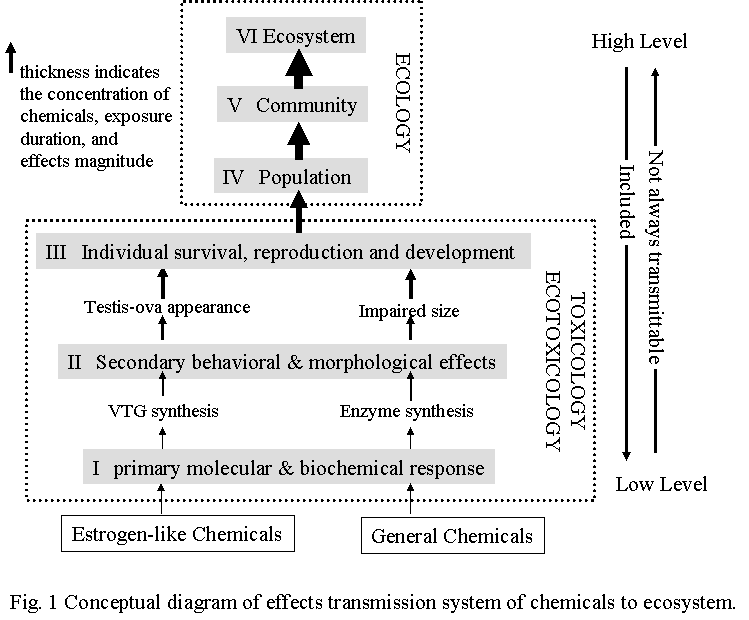The Ecological Risk Analysis Team (ERAT) was established within CRM in April 2004. ERAT consists of nine staff members (five researchers and four technical staff members) with Dr. Bin-Le Lin as the team leader.
Several research topics categorized as Longitudinal Research or Latitudinal Research under ERAT are described below. Among these research topics, some of them are performed in cooperation with Hydrosphere Environment Assessment Team.
Longitudinal Research Topics
For the purpose of assisting rational decision-making for chemical risk management, making environmental safety and chemical use compatible, ERAT mainly focuses on developing methodologies to quantitate the likelihood and magnitude of adverse effects of chemical substances on ecology defined as “Ecological Risk” from two aspects: science and management.
In addition to this, as an indispensable tool for diagnosing and evaluating the ecological risk occurred in the real environment, development of a basin-wide ecological model for watershed area, which explains the mechanism of emission amounts of chemical substances and inland water quality based on the distributed modeling approach, is also conducted.
Unlike human health risk assessment, ecological risk assessment (ERA) lags behind because there are a lack of operational methodologies and the complexity of ecosystem. The conceptual diagram shown in Figure 1 depicts the mechanism of how the effects of released chemical substances are passed onto the ecosystem and environment.
In other words, chemical substances that are introduced to the ecosystem are transmitted and accumulated gradually from lower to higher hierarchical levels, depending on the exposure concentration, duration, and the magnitude of the effects. When chemical substances are released into the environment, they first affect biochemical responses at both the enzyme and cellular levels of organisms.
For example, estrogen-like chemical substances can affect vitellogenin and enzyme synthesis in fish (Figure 1). If the degree of these effects is severe, then the effects on biochemical responses accumulate and are transmitted to the fish’s tissues, behaviors, and morphology. As a result, the fish develops tissular or morphological abnormalities such as testis-ova. If the effects of these tissular abnormalities are further accumulated and transmitted, they will influence the fish’s survival, growth, and reproduction processes.
Conventional impact assessment parameters, such as LC50, NOEC, and HQ (hazard quotient), usually precisely follow this hierarchical assessment. As more and more individuals show individual-level impacts, the effects are gradually accumulated and transmitted from the conventional eco-toxicological sphere to a higher ecological sphere that includes the population level, community level, and finally ecosystem level (Figure 1).
Generally, effects at the lower hierarchical levels of biology (such as I and II in Figure 1) will not necessarily be transmitted to higher levels (higher than IV) as ecological impacts. For example, the death of one individual from the effects of chemical toxicity does not necessarily influence the function and structure of the entire ecosystem.
By contrast, at a population level we have a pool of individuals of the same species living within a specific area, and the population acts as an entity with ecological functions. If the effects of chemical toxicity wipe out this population, then the functions and structures of the ecosystem will be affected. Therefore, to protect an ecosystem from chemical effects, chemical effects at a population level rather than at an individual level should be the basis of ERAs.
Until now, eco-toxicologists have studied population-level assessment methods that use knowledge obtained from population ecology. Such methods integrate individual-level toxicological information with population ecology to provide useful assessments of the population-level effects of toxic contaminants. However, there have been no reports of a rational framework for incorporating these scientific perspectives on population-level ecological risk assessment (PLERA) of chemical substances into the context of chemical substances management.
In particular, still has few formulated feasible assessment endpoints or methods of conducting such assessments to provide guidance, e.g. a target value for ecological impacts usually defined as predicted-no-effect concentration (PNEC) for environmental policy from a population-level viewpoint. To develop a practical and rational framework for PLERA that can be applied to chemical management policies, ERAT has proposed two feasible population-level approaches through a case study of 4-nonylphenol (Lin et al., Environmental Science & Technology, Vol. 39, No. 13, 2005).
Future researches of ERAT will concentrate on: (1) improving and formalizing ERAT’s proposed approaches by application to more chemical substances; (2) accumulating many more case studies for developing more flexible and practical methodologies under the limited toxic data currently available; and (3) establishing a rational and practical ERA system with PLERA as backbone.
Research topics currently under taken:
(1) Research on methodologies for ERA, principally on PLERA;
(2) Research on bioaccumulation modeling for evaluation exposure through food-chain;
(3) Research on environmental dynamics modeling for chemical substances in hydrosphere;
(4) Research on PLERA framework and methodologies for evaluating impacts of potential endocrine disrupting chemical substances; and
(5) Development of toolbox for ERA for general application.

Latitudinal Research Topics
For the purpose of assisting regulatory agencies, industries and general public to make scientific and rational decisions in chemical risk management, ERAT carries out risk assessment of specific chemical substances that are expected to pose high potential risk to ecosystem.
The following are the substances that ERAT has been working on:
(1) Already released to public: Nonylphenol, di-(2-ethylhexyl) phthalate;
(2) Expected to be released in FY 2005: co-PCB, Lead, Alcohol ethoxylates; and
(3) Expected to be finished in FY 2005: Zinc, chloroform